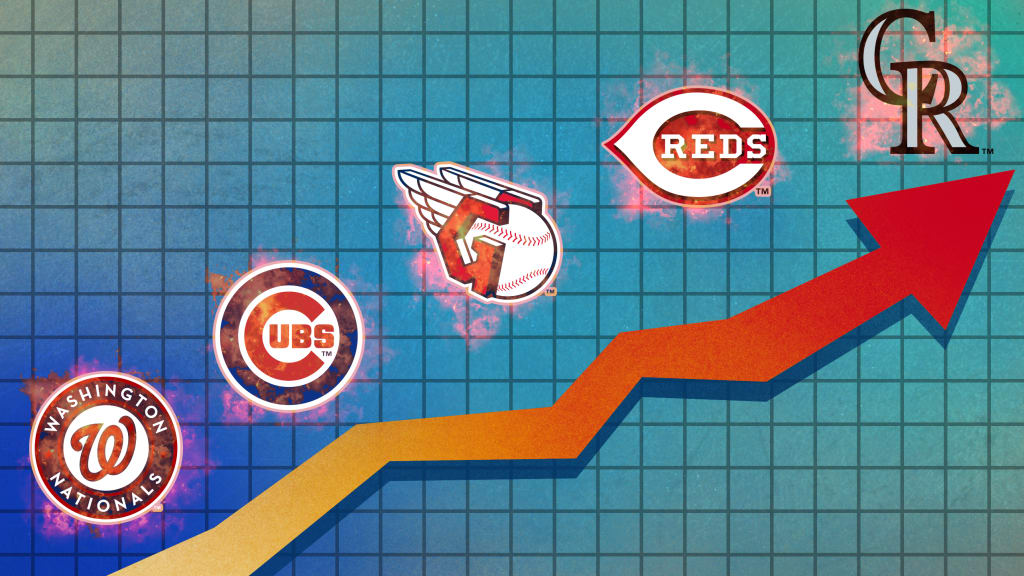
It’s the last week of the calendar year. Time for some good old-fashioned retrospection.
The whole point of “development” in the oft-used phrase “player development” is to make prospects better little by little until they’re wholly improved from their status from the beginning of the season. Multiply that by dozens and dozens of players in each organization, and you could end up with entire systems that have improved by leaps and bounds in a matter of a few months.
What constitutes improvement might be subjective, but we have a pretty good measure of that improvement over time in the MLB Pipeline Farm System Rankings. Every spring, we rank the organizations 1-30 based on their overall Minor League talent, both in terms of ceiling and depth. Then around the second half of the season, we update those rankings to coincide with our fresh Top 100 overall and Top 30 team lists that include new breakout names and top Draft picks. Compare the two, and you can find which teams made the biggest leaps in the lower levels.
The end of the Minor League season, the Arizona Fall League and offseason trades may have impacted how we view some of these groups a little since then, but for the most part, these are the five systems that showed the largest improvements in 2022:
1. Rockies
Preseason rank: 24
Re-rank: 9
Colorado only boasted one Top 100 prospect to begin the season in Zac Veen. The outfielder remains at the top of the Rockies list at No. 23 overall, but he’s since been joined by Ezequiel Tovar (No. 27), Adael Amador (No. 61) and Drew Romo (No. 63). Tovar’s development, in particular, was a big reason for the jump. Already known as a special defender at shortstop, the 21-year-old showed an improved bat at Double-A Hartford and finished out the season with nine games in the bigs. The National League West club also addressed its much-needed pitching corps depth by taking Gonzaga right-hander Gabriel Hughes 10th overall in the Draft, and his three-pitch mix, highlighted by his easy mid-90s velo, could get him into the Top 100 himself early in his career.
2. Reds
Preseason rank: 15
Re-rank: 4
The story of the Reds' system in 2022 was the development of top prospect Elly De La Cruz, who finished with 28 homers and 47 steals in 120 games at High-A and Double-A -- numbers that match his electric power and speed tools. But Cincinnati also added both depth and ceiling to its Minor League core through its blockbuster trade with the Mariners that sent out Luis Castillo for Top 100 prospects Noelvi Marte (No. 17 overall) and Edwin Arroyo (No. 52), among two others. No. 8 Draft prospect Cam Collier fell in the first round before the Reds were happy to pick him at No. 18, and the 18-year-old third baseman adds even more infield thump to the mix. Moving Tyler Mahle (Spencer Steer, Christian Encarnacion-Strand) and Brandon Drury (Victor Acosta) gave the group more length, even after the graduations of top prospects Hunter Greene and Nick Lodolo during the summer.
3. Guardians
Preseason rank: 12
Re-rank: 3
Cleveland certainly has a type. It selects a college pitcher with good control in the Draft, tightens up his stuff, adds a little velo and watches him take off as a Minor League starting pitcher. Gavin Williams, Tanner Bibee and Logan Allen all fit the bill quite nicely in 2022 with the first two cracking into MLB Pipeline’s Top 100 as a result. What Daniel Espino lacks in similar control, he made up for in elite stuff with his 70-grade heater and 65-grade slider -- each of which he showed off in a short Double-A spurt before knee and shoulder injuries ended his season. It didn’t stop at pitchers though. Bo Naylor rebounded from a '21 season in which he posted a .612 OPS at Double-A to produce an .888 OPS in 118 games at the Minors’ top two levels, thanks to a more disciplined approach. The Guardians may have sneakily become one of the deepest systems in the game, but the word is certainly out now.
4. Cubs
Preseason rank: 18
Re-rank: 10
It’s difficult to think of now, but Pete Crow-Armstrong began the season with only six Minor League games on his résumé due to a torn labrum in his right shoulder. Fully healthy in 2022, he blossomed into a promising hitter who is capable of being an elite defender in center field, thus making him MLB Pipeline’s No. 30 overall prospect. He’s one of three Top 100 prospects for the Cubs now, all of which are outfielders, alongside Brennen Davis (No. 48) and breakout performer Kevin Alcantara (No. 86), who like Crow-Armstrong, was acquired in a '21 trade. The selection of College World Series star Cade Horton at No. 7 in the 2022 Draft was a big swing that could pay off if the former Sooners right-hander’s plus fastball and 65-grade slider translate well to the pros. Somehow, we’ve gotten this far without mentioning 36-homer man Matt Mervis, who went from obscurity to being potentially the Cubs’ Opening Day first baseman -- essentially the poster boy for the system’s improvements since the spring.
5. Nationals
Preseason rank: 23
Re-rank: 15
Look, if you trade a franchise player like Juan Soto, your farm system better improve by leaps and bounds. As it stands between that blockbuster with the Padres and the July Draft, five of the Nats’ top nine prospects weren’t in the organization at the start of the season, and that doesn’t count prospect graduates CJ Abrams and MacKenzie Gore who served as big trade pieces from San Diego. Outfielders Robert Hassell III, Elijah Green and James Wood have given the Nats a new Big Three, and don’t be surprised if former Padres flamethrower Jarlin Susana works his way into the Top 100 as he adds innings. It’s one big thing to add a lot of talented pieces. It’s another to develop them into impactful Major Leaguers. Check back in December 2023 to see how the Nats -- and many other systems -- have progressed.


